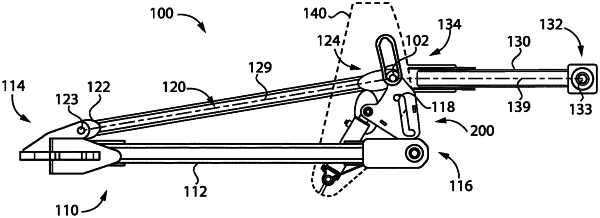| CPC B60D 1/1675 (2013.01) [B60D 1/42 (2013.01); B60D 1/246 (2013.01)] | 20 Claims |

|
1. A hitch assembly, comprising:
a main frame comprising a projection;
a first link pivotably coupled to the main frame;
a second link pivotably coupled to the first link by a pivot pin; and
a self-locking actuator mechanism, comprising:
a floating plate defining a first slot, the first slot comprising a first central portion, a first jog extending laterally from a first end of the first central portion, and a second jog extending laterally from a second end of the first central portion, wherein the projection extends into the first slot, and wherein the floating plate is pivotably coupled to the first link and the second link; and
a linear actuator mounted to the main frame, the linear actuator comprising a shaft pivotably connected to the floating plate;
wherein the hitch assembly has a first state in which the shaft is in a first shaft position, the floating plate is in a first plate position, and the projection is received in the first jog to thereby lock the first link and the second link at a first relative orientation;
wherein the hitch assembly has a second state in which the shaft is in a second shaft position, the floating plate is in a second plate position, and the projection is received in the second jog to thereby lock the first link and the second link at a second relative orientation different from the first relative orientation; and
wherein the linear actuator is operable to drive the shaft between the first shaft position and the second shaft position to thereby move the hitch assembly between the first state and the second state.
|